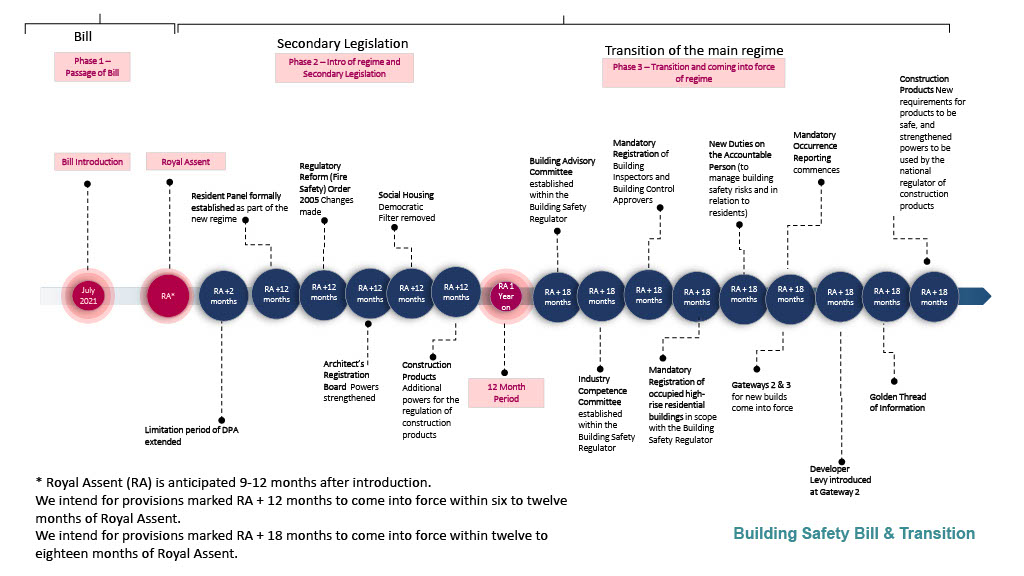
The Building Safety Act 2022 provides a framework for a fundamental change in the design and construction of all buildings.
This new legislation focuses on improving building safety and enforcing government policies to make the construction industry (and residential developers in particular) pay for the repairs of historic fire safety defects.
The purpose of this Bill is to close compliance loopholes in the construction industry and to provide clearer accountability. The management and monitoring of a building will be governed by stricter 'lifecycle' frameworks.
What does the Building Safety Act 2022 mean for fire rated glazing companies?
Social landlords should consider accessibility, thermal, acoustic, durability, and security performance when choosing fire rated glass doors, windows, or screens.
To ensure the product will perform in an emergency, installation must follow manufacturer instructions and be supported by regular maintenance.
Upon approval of a new building by the regulator, the accountable person and building safety manager are required to keep all relevant data up-to-date, including any refurbishments. Building safety managers and accountable persons are responsible for maintaining this information in existing buildings.
The process of maintaining and updating information is not outlined in any standards yet. Details of fire-rated doors and windows, ironmongery, manufacturer details and third-party certification, installation details, maintenance records, and plans should be easily accessible in digital format.
A vital requirement is that all information for each door, window or screen be traceable back to its manufacturer and third-party certification. Documents and data sheets from third parties should also be available to the public.
When choosing a manufacturer, landlords should look for ones that provide clear, reliable test evidence, as well as transparency regarding how the tests were conducted and the results achieved.
Making that information easily accessible for stakeholders, gives them more confidence about the product being specified.
What is the Gateway process and Golden Thread?
A new 'Gateway' procedure will ensure building safety risks are evaluated during planning, design, construction, and pre-occupation.
· Planning Gateway one – at the planning application stage
· Gateway two – before building work starts
· Gateway three – when building work is completed
All three Gateways are intended to create a ‘Golden Thread’ of safety information about a building, ensuring the right information is available to the right people, at the right time.
The information needs to be accurate, easily understandable, up to date and easily accessible.
What impact will the Building Safety Act 2022 have on the construction industry?
In the years to come, the Act will create a framework for designing, building, and managing safer, high-quality homes.
The new Bill will ensure all construction products on the UK market are safe for their intended use, with a National Regulator for Construction Products monitoring and enforcing this.
Highrise building designers and contractors will have to manage significant changes during the design and construction phase of highrise buildings because of the introduction of 'Gateways' and 'Golden Thread'.
Over time, highrise buildings will be subject to several new mandatory reporting and registration requirements. Among them will be the registration of all occupied highrise buildings with the Building Safety Regulator, the mandatory reporting of fire and structural issues, as well as the registration of all building inspectors and building control approvers.
Does the building safety bill apply to all buildings?
In its current form, the law applies to high-risk residential buildings (high-rise apartment blocks, student housing, hospitals, and larger care homes) that are over 18m tall or have seven or more stories.
The transition period
Depending on the amount of work, the various provisions should take effect two to 18 months following Royal Assent. Some key expected timelines for fire safety professionals to be aware of (dates are related to the time after the Bill achieves Royal Assent) include:
- Changes made to the Regulatory Reform (Fire Safety) Order 2005 – Within 6-12 months
- Additional powers for the regulation of construction products – Within 6-12 months
- Building Advisory Committee and Industry Competence Committee established within the Building Safety Regulator (12-18 months)
- Mandatory registration of Building Inspectors, Building Control Approvers, Occurrence Reporting and registration of occupied high-rise residential buildings (12-18 months)
- New duties on the accountable person to manage building safety risks (12-18 months)
- Golden threat of information (12-18 months)

Photo Credit: www.gov.uk
Who is responsible for fire safety in a building? Protecting leaseholders and ensuring that the responsible are accountable
New roles
Accountable person
Part 4 of the Building Safety Act names 'accountable persons' for residential high-rise buildings. This will be the organisation or person who owns or has responsibility for the building. It may also be a person or organisation responsible for maintaining a building's corridors or lobbies.
Existing roles with new responsibilities
During design and construction
Existing duty holders under the Construction (Design and Management) Regulations 2015 will have new duties. These duty holders are clients, designers, principal designers, contractors and principal contractors. Their new duties will be to:
- plan
- manage
- monitor
- their activities in relation to building regulations.
Find out more information in the factsheet about duty holders
It goes without saying that the Building Safety Act 2022 will have a huge effect on the real estate and construction industries in the UK, particularly for residential construction. The Act's full significance won't be known for some time, so we'll continue to monitor developments in the coming months.
Share article
Have a question or need a quote?
We are here to help
Call us on +44 (0)1342 836630 to discuss your fire rated install requirements


